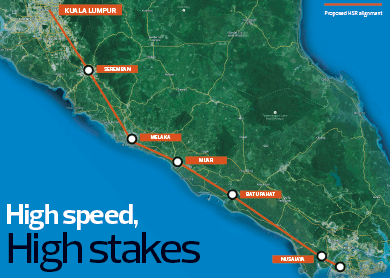
 SURUHANJAYA PENGANGKUTAN AWAM DARAT (SPAD) CEO Mohd Nur Ismal Mohd Kamal has to be tight-lipped about the details of the high-speed rail (HSR) project because talks are ongoing with the Singapore government. But he is clearly excited about the possible benefits of the project to Malaysia. In a rare interview, Nur Ismal shares with The Edge his vision of the project and some of the challenges he foresees.
SURUHANJAYA PENGANGKUTAN AWAM DARAT (SPAD) CEO Mohd Nur Ismal Mohd Kamal has to be tight-lipped about the details of the high-speed rail (HSR) project because talks are ongoing with the Singapore government. But he is clearly excited about the possible benefits of the project to Malaysia. In a rare interview, Nur Ismal shares with The Edge his vision of the project and some of the challenges he foresees.
The Edge: How do you feel about taking on this massive project?
Mohd Nur Ismal Mohd Kamal: We are very excited. This is a fantastic project for the country and I really want to see it happen. At SPAD, we are 100% committed to see this project through.
It will produce huge economic development for both Malaysia and Singapore as it brings Kuala Lumpur and the city-state closer together.
What is the status of the negotiations with Singapore?
We have agreed on about 50% of the issues and we have another 50% to go. We aim to complete the discussions by the end of the year.
Have you decided on the alignment yet?
We have pretty much decided on the alignment; we are just working out some final details. As reported, we are looking at the coastal alignment that will run through Nusajaya, Muar, Batu Pahat, Melaka, Seremban and Putrajaya.
What are the main issues that you are sorting out with Singapore?
There are many issues [laughs]. But that is to be expected of a project so large.
We understand the final station on Singapore’s end is an issue. Can you elaborate?
We would prefer to terminate the line at the existing CIQ (customs, immigration and quarantine) complex. However, Singapore wants it to terminate in Jurong East and understandably so. Just as we want to develop Bandar Malaysia, they want to use the HSR to drive development in Jurong East.
From our perspective, by terminating at the CIQ, the entire project will be within our borders and we will have more control of it. This will be closer to Orchard Road than Jurong East. But of course, we have to weigh Singapore’s economic and commercial considerations as well to come to an agreement.
What about the six additional transit stations that Malaysia wants. Is Singapore willing to bear the cost?
The cost of the six additional stations is very small. Less than 10% of the entire project. Much less than 10%, in fact. The development of the areas surrounding the station should be able to cover the cost of building the stations.
Take Japan. It generates 30% to 50% of its revenue from the commercial activities and development in the areas around the stations.
Because the additional stations will benefit Malaysia more, Singapore is not so keen on the transit line. However, just as we must take its economic and commercial considerations into account, it must also take care of us. There has to be give and take so that both parties can benefit.
Do you think the estimated cost of RM40 billion for the HSR is enough?
We can’t comment on the cost. We want to take this to an international tender and we want the bids to be as competitive as possible. If we let them know what number we have in mind, their bids will come in around there; we don’t want that.
What are the biggest challenges you foresee?
The HSR isn’t just a transport project. It is a socio-economic development project. The government needs to ensure that it puts in place the right policies to support the project beyond the scope of tracks and stations. For example, special economic zones for certain industries can be set up near the stations to drive development.
We also have to be as competitive as Singapore. Ultimately, we want foreigners to look at Singapore and KL and see one megacity, not two separate cities.
But that is outside my scope. Within my scope, the construction of the project must be done at the lowest cost possible. Contractors can’t come into the project hoping to make big margins.
And while we want to keep costs low, we have to make sure that the project delivers. Sure, we can go with a cheaper alignment or save cost on certain technologies. But at what cost? The cost to rectify problems in the future might be even more expensive.
We need to make sure the project isn’t just good but great.
Are you worried about the project becoming politicised?
Fortunately, the project hasn’t been politicised yet. We hope it stays that way so that we can do what is best for the country. We don’t want politics to hamper our ability to make decisions. We will make sure the proper processes are followed so that the project is as transparent as possible.
Even as you are doing this project, are you thinking about a connection to Thailand as part of a pan-Asean network?
Absolutely. There is a reason why we refer to this project as the ‘Southern Corridor HSR’.
This article first appeared in The Edge Malaysia Weekly, on June 15 - 21, 2015.
Save by subscribing to us for your print and/or digital copy.
P/S: The Edge is also available on Apple's AppStore and Androids' Google Play.